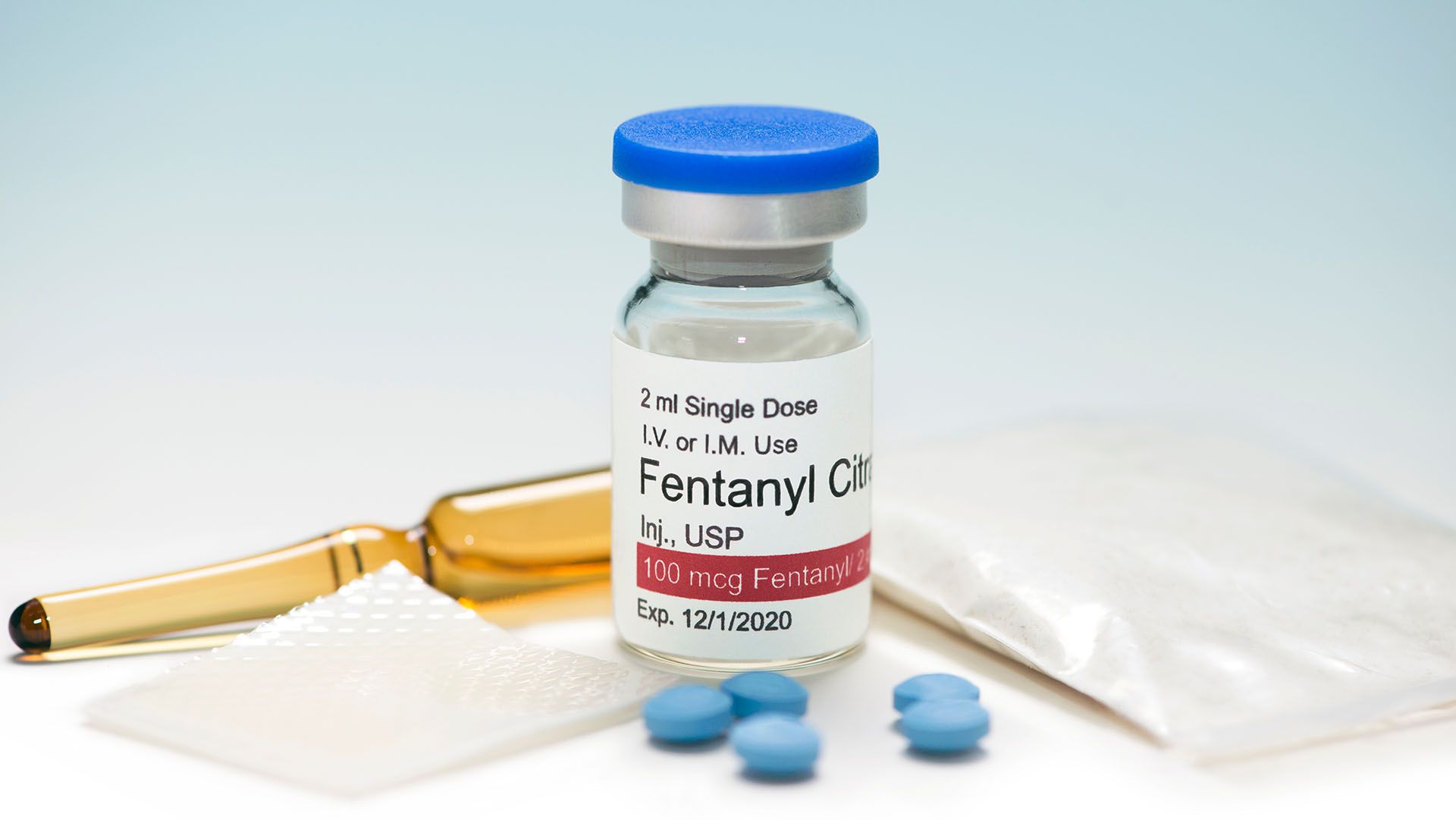What is the Fentanyl?
Fentanyl is a synthetically produced opioid drug that is prescribed as a painkiller. It can be safely administered by healthcare professionals to patients who are experiencing constant severe pain and is often used to treat terminal cancer patients. Prescribed fentanyl is commonly known as Actiq, Sublimaze or Duragesic. The drug may be administered in such a way that it releases slowly into the body by way of a patch, or in the form of lozenges that are ingested so that the drug can be absorbed into the bloodstream to treat breakthrough pain. Fentanyl is incredibly strong, which is why a slow-release method is used – fentanyl can be 100 times stronger than morphine and 50 times stronger than heroin, which is what makes it such a dangerous drug when abused.
Fentanyl as a Street Drug: Social Context
In the midst of the opioid crisis in Canada and the United States, fentanyl is particularly dangerous because of its potency. Common street names for the drug are Apache, China Girl, China White, Dance Fever, Goodfella, Tango, and TNT. When used recreationally as a street drug, fentanyl is most often produced as a powder and sold as a powder or a pill. It is easy to overdose on fentanyl because the drug is often mixed with another substance, such as heroin or cocaine, so the user may ingest it without even knowing.
Opioids are prescribed to treat pain, and when used recreationally they can produce feelings of euphoria, drowsiness or relaxation. Recreational opioid use in Canada has increased drastically: it is estimated that between January 2016 and September 2018, 10,300 Canadians died from an apparent opioid-related overdose (Public Health Agency of Canada, June 2019). Fentanyl contributes significantly to the accidental overdose rate, and in 2018 alone, 73% of accidental apparent opioid-related deaths involved fentanyl or fentanyl analogues (National Report: Apparent Opioid-Related Deaths in Canada).
An example of a high-profile case of a fentanyl overdose is the death of Pop superstar Prince in 2016. There was speculation that the painkillers he was taking were counterfeit and had a high fentanyl content, which ultimately resulted in an overdose. This case is only one example of many thousands of deaths resulting from an accidental fentanyl dose, where the user is under the impression that they’re taking another opioid.
Where did Fentanyl Come from?
Fentanyl was created in 1960, as scientists were looking to refine naturally existing opioids for medical uses. It was intended to produce a stronger effect with higher safety margins (when used in a medically supervised environment) and was first used as an intravenous drug called Sublimaze. Following the success of Sublimaze, variations of fentanyl were produced, such as Sufentanil, Alfentanil, Lofenanil and Remifentanil. The now-popular patch was produced in the 1990s and was successful in managing pain over a longer period of time due to the fact that when the drug is transmitted through the skin and into fat, it is released into the bloodstream slowly and can last over a period of two to three days. Today, there are more FDA-approved options such as lozenges and nasal sprays for more immediate relief of breakthrough pain symptoms.
Fentanyl was not created with the intention of being available for mass-market purchase, but due to its highly addictive nature and potency, it is frequently consumed and sold as a street drug.
What Happens to Your Body When You Use Fentanyl?
Because of its high potency, fentanyl is incredibly addictive. Users may only have to ingest the drug once or twice to become dependent. Opioid drugs work by attaching to the brain’s opioid receptors, which are responsible for transmitting data on pain and emotion. When taken as prescribed by a doctor or healthcare professional, the patient is in excessive amounts of pain, so the drug is used to limit the power of the pain message to the brain, allowing the patient to be more comfortable. As a person uses opioid drugs more often, their receptors become acclimatized to the drug, and they can become dependent on it. When used in low doses, fentanyl and other opioids minimize feelings of pain: however, if too much is ingested, opioids can slow your breathing and heart rate, which limits the amount of oxygen that reaches the brain, resulting in hypoxia. Hypoxia can lead to a coma, and it can also be fatal.
Street fentanyl is extremely dangerous because there is no way to tell how strong the dose is, especially if the user is under the impression that they are taking something else entirely, without knowing that the product has actually been contaminated by fentanyl.
Side effects of recreational fentanyl use:
People who take recreational fentanyl may experience:
- extreme happiness, or a “high”
- drowsiness
- confusion
- loss of consciousness
- trouble breathing
- nausea
As fentanyl is considerably stronger than other opioids, the euphoric side effects can be much stronger, making the drug significantly more addictive. It is important to note that the recreational use of fentanyl can result from the misuse of a prescription. There is a stigma that “drug users” look and behave a certain way – however, a drug user is anyone who is abusing substances in any way, whether by buying illicit drugs on the street or by taking the incorrect dosage of prescription medication.
What Are Some Signs of Fentanyl Addiction?
Fentanyl and opioid addiction doesn’t necessarily start from buying drugs off the street. Because opioids are prescription painkillers, dependency can stem from misusing or over-consuming a prescription. Addiction can be a slippery slope as your body becomes more dependent on the drug for relief, and people may eventually seek out other sources of opioids for something stronger.
Some signs of opioid addiction include:
- taking more than the doctor’s prescribed dosage
- taking medication not prescribed by a doctor
- taking opioids preemptively to avoid pain
- changes in sleep patterns
- having prescriptions from multiple doctors for the same medication (“doctor shopping”)
- mood swings
How is a Fentanyl Overdose Treated?
The following symptoms may indicate that a person has overdosed on fentanyl:
- slow breathing patterns, or no signs of breathing at all
- lips and nails are blue in light-skinned individuals; the inside of the lips are blue in darker-skinned individuals
- loss of consciousness
- pupils are very small
- the skin feels cold and clammy to the touch
- the individual is emitting gurgling sounds or snoring
Naloxone is a medicine that can be used to treat a fentanyl overdose if given right away. First responders have supplies of Naloxone, and the medicine is available over the counter in both the United States and Canada (currently with the exception of the province of Alberta). The medicine works by blocking the body’s opioid receptors from absorbing any of the drugs – this is why it needs to be taken quickly before the body has a chance to absorb the fentanyl. Because fentanyl is much stronger than other opioids, it can require a higher dose of naloxone to combat it. Naloxone is available as an injectable or as a nasal spray, and when it is administered, it can help regulate breathing to a normal rate.
How is Fentanyl Addiction Treated?
Methadone or buprenorphine treatments, commonly referred to as opioid agonist therapies, can be part of a treatment plan for fentanyl and opioid addiction. These medications help to minimize withdrawal symptoms (see next section) patients experience. Methadone and buprenorphine are still opioids, but they work at a slower release rate without the intense high that fentanyl is known for, so someone undergoing methadone treatment for opioid addiction is able to slowly reduce their dosage and frequency. These treatment options are available in pharmacies. Methadone treatment is often a powder mixed into a drink, and buprenorphine is frequently combined with naloxone into a pill form.
Methadone clinics are becoming more commonplace in large cities across Canada, despite criticism and protest from the general public. A lack of understanding of the treatment is apparent – it is true that patients are still consuming an opioid; however, they are doing so in controlled doses in order to mitigate withdrawal symptoms from something much stronger. These clinics are a much safer option for an individual who is detoxing, where they have access to help, and resources to help them treat their addiction.
Traditional counselling services are also beneficial to patients treating fentanyl and opioid addiction. Addiction is never a simple, one-stop fix, as there are often multiple layers and underlying issues that need to be addressed. Each individual will have his or her own path to recovery.
Rehabilitation programs or rehab centres can teach patients different strategies for managing withdrawal symptoms and mentally overcoming addiction, that they can integrate into their lives in order to prevent a relapse into addictive patterns and behaviours. Often, patients may experience a period of being drug-free, but it is those who are able to maintain healthy habits who are most successful at a true detox.
Withdrawal Symptoms:
Fentanyl withdrawal symptoms can include:
- bone and muscle aches
- problems sleeping
- vomiting and diarrhea
- chills
- uncontrollable shaking in the extremities
As fentanyl is much stronger than other opioids, withdrawal symptoms can come on in as little as a few hours after the last dose of the drug. This is what makes this substance particularly addictive – the highs can be intense, and the lows come quite quickly thereafter, so many people continue to take the drug again, thinking that they can avoid the withdrawal symptoms.
Support for Caretakers
It is important to note that caretakers for those who are treating fentanyl addiction or any substance use disorders can quickly experience burnout and emotional distress. Navigating government systems and various therapies and supports can be daunting: but it can be helpful to connect with other individuals who are experiencing the same challenges. While counselling services are undoubtedly beneficial for those experiencing addiction or withdrawal, they can also be helpful for caretakers. It is important to remember that you’re not alone and that there are resources available.







